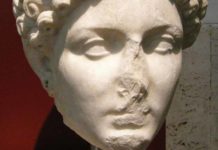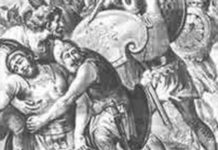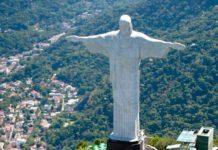The mausoleum of Ateban in Thugga, fifty miles to the south-west of Carthage in what was Numidia, stands an impressive 69 ft/21 metres high.
Built originally at the beginning of the second century BC, the mausoleum reflects the very high status of its subject. This reconstructed monument is assumed to be a faithful copy of the original and displays the fusion of Numidian, Greek and Egyptian architectural styles that together produced the Punic style, established in Numidia before Rome took control. The upper part of the Mausoleum is reminiscent of the tall, pointed grave markers of the same era.
The monument was partially demolished in 1842 when slabs bearing Libican and Punic inscriptions were removed. The two inscriptions recorded the same information, indicating two different cultures in the same area. The inscription records “Ateban son of Ypmatat”, an African form of naming, and represents an individual roughly contemporary with Masinissa who in 238 BC became king of the united Numidian tribes and encouraged Carthaginian customs including settled agriculture and urban development. (This might account for the two languages on the monument.)
It is arguable that the house-like form of the mausoleum might suggest it was set up by people who lived in houses rather than as nomads. The mausoleum has a stepped base leading up to an enclosed rectangular sector with blind window-like features on each side and lotus flower scrolled capitals on the corners showing Egyptian/Greek influences. Above this, more steps lead up to a smaller rectangular sector with embedded ionic columns which again are Greek forms. This is surmounted with an Egyptian-style moulding. Three more steps, with horsemen at each corner, lead up to a rectangular tower with a bas-relief of a chariot carrying two people, reminiscent of Egyptian and Greek art. The top section with its pyramid is decorated with more Egyptian-style mouldings and sculptures. Overall, however, the form of the monument seems indebted to Greek influences in the main and certainly suggests a high regard and interest in that culture by this Punic king.
Excavation of Thugga
More examples of what seems to be a fusion of cultures are found in some of the buildings in Thugga. An established Punic settlement, its non-Roman street layout is detectable but the pre-Roman city walls delineate an area which has been only partially excavated. The crisp geometry of the Roman buildings is in stark contrast to the higgledy-piggledy streets and irregular shaped Punic houses. All the buildings sited outside the city walls appear to be Roman with the exception of the mausoleum of Ateban and a cemetery area to the north west of the old city wall.
However, evidence suggests that the temple of Saturn was built over a temple to Baal, an example of syncretism where two deities are combined, another example being the temple of Ceres who was both a Punic and a Roman goddess. The Capitolium, dedicated to the three Roman deities, Jupiter, Juno and Minerva, shows both adherence to and divergence from traditional Roman temple forms. Ironically, this and other temples near the Square of the Wind Rose* do not conform to the the Roman architect, Vetruvius’ advice that buildings should not face the wind.
Also the temple is built to the side of the forum, rather than at the end of it as at Ostia, for example. The Corinthian columns of the temple are one of several definitely Roman features but the walls are built in the indigenous opus Africanum style. One explanation for this might be that Roman or Romanised architects laid the plans for a temple to a Roman god and African workmen used traditional building methods where practicable.
Notes:
*A paved area with an inscribed 12-point “rose” indicating wind directions








